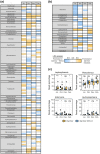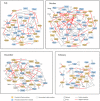Impact of a resistance gene against a fungal pathogen on the plant host residue microbiome: The case of the Leptosphaeria maculans-Brassica napus pathosystem
- PMID: 32975002
- PMCID: PMC7694673
- DOI: 10.1111/mpp.12994
Impact of a resistance gene against a fungal pathogen on the plant host residue microbiome: The case of the Leptosphaeria maculans-Brassica napus pathosystem
Abstract
Oilseed rape residues are a crucial determinant of stem canker epidemiology as they support the sexual reproduction of the fungal pathogen Leptosphaeria maculans. The aim of this study was to characterize the impact of a resistance gene against L. maculans infection on residue microbial communities and to identify microorganisms interacting with this pathogen during residue degradation. We used near-isogenic lines to obtain healthy and infected host plants. The microbiome associated with the two types of plant residues was characterized by metabarcoding. A combination of linear discriminant analysis and ecological network analysis was used to compare the microbial communities and to identify microorganisms interacting with L. maculans. Fungal community structure differed between the two lines at harvest, but not subsequently, suggesting that the presence/absence of the resistance gene influences the microbiome at the base of the stem whilst the plant is alive, but that this does not necessarily lead to differential colonization of the residues by fungi. Direct interactions with other members of the community involved many fungal and bacterial amplicon sequence variants (ASVs). L. maculans appeared to play a minor role in networks, whereas one ASV affiliated to Plenodomus biglobosus (synonym Leptosphaeria biglobosa) from the Leptosphaeria species complex may be considered a keystone taxon in the networks at harvest. This approach could be used to identify and promote microorganisms with beneficial effects against residue-borne pathogens and, more broadly, to decipher the complex interactions between multispecies pathosystems and other microbial components in crop residues.
Keywords: ecological network analysis; metabarcoding; microbial communities; microbiome; oilseed rape residues; pathobiome; stem canker.
© 2020 The Authors. Molecular Plant Pathology published by British Society for Plant Pathology and John Wiley & Sons Ltd.
Figures





Similar articles
-
Oilseed rape (Brassica napus) resistance to growth of Leptosphaeria maculans in leaves of young plants contributes to quantitative resistance in stems of adult plants.PLoS One. 2019 Sep 12;14(9):e0222540. doi: 10.1371/journal.pone.0222540. eCollection 2019. PLoS One. 2019. PMID: 31513677 Free PMC article.
-
Co-inoculation timing affects the interspecific interactions between phoma stem canker pathogens Leptosphaeria maculans and Leptosphaeria biglobosa.Pest Manag Sci. 2024 May;80(5):2443-2452. doi: 10.1002/ps.7799. Epub 2023 Oct 11. Pest Manag Sci. 2024. PMID: 37759352
-
Transcriptome analysis of the Brassica napus-Leptosphaeria maculans pathosystem identifies receptor, signaling and structural genes underlying plant resistance.Plant J. 2017 May;90(3):573-586. doi: 10.1111/tpj.13514. Epub 2017 Mar 27. Plant J. 2017. PMID: 28222234
-
Status and advances in mining for blackleg (Leptosphaeria maculans) quantitative resistance (QR) in oilseed rape (Brassica napus).Theor Appl Genet. 2021 Oct;134(10):3123-3145. doi: 10.1007/s00122-021-03877-0. Epub 2021 Jun 9. Theor Appl Genet. 2021. PMID: 34104999 Free PMC article. Review.
-
Recent Findings Unravel Genes and Genetic Factors Underlying Leptosphaeria maculans Resistance in Brassica napus and Its Relatives.Int J Mol Sci. 2020 Dec 30;22(1):313. doi: 10.3390/ijms22010313. Int J Mol Sci. 2020. PMID: 33396785 Free PMC article. Review.
Cited by
-
Distinct Phyllosphere Microbiome of Wild Tomato Species in Central Peru upon Dysbiosis.Microb Ecol. 2023 Jan;85(1):168-183. doi: 10.1007/s00248-021-01947-w. Epub 2022 Jan 18. Microb Ecol. 2023. PMID: 35041070 Free PMC article.
-
Differences in the Production of Extracellular Polymeric Substances (EPS) and Other Metabolites of Plenodomus (Leptosphaeria) Infecting Winter Oilseed Rape (Brassica napus L.).Metabolites. 2023 Jun 17;13(6):759. doi: 10.3390/metabo13060759. Metabolites. 2023. PMID: 37367918 Free PMC article.
References
-
- Abarenkov, K. , Nilsson, R.H. , Larsson, K.‐H. , Alexander, I.J. , Eberhardt, U. , Erland, S. et al (2010) The UNITE database for molecular identification of fungi—recent updates and future perspectives. New Phytologist, 186, 281–285. - PubMed
-
- Aubertot, J.‐N. , Schott, J.‐J. , Penaud, A. , Brun, H. and Doré, T. (2004) Methods for sampling and assessment in relation to the spatial pattern of Phoma Stem Canker (Leptosphaeria maculans) in oilseed rape. European Journal of Plant Pathology, 110, 183–192.
-
- Baird, R.E. , Philips, D.V. , Mullinix, B.G. and Alt, P.J. (1999) Relative longevity of Leptosphaeria maculans and associated mycobiota on canola debris. Phytoprotection, 80, 1–11.
-
- Balesdent, M.‐H. , Fudal, I. , Ollivier, B. , Bally, P. , Grandaubert, J. , Eber, F. et al (2013) The dispensable chromosome of Leptosphaeria maculans shelters an effector gene conferring avirulence towards Brassica rapa . New Phytologist, 198, 887–898. - PubMed
-
- Banerjee, S. , Schlaeppi, K. and van der Heijden, M.G.A. (2018) Keystone taxa as drivers of microbiome structure and functioning. Nature Reviews Microbiology, 16, 567–576. - PubMed
Publication types
MeSH terms
LinkOut - more resources
Full Text Sources

